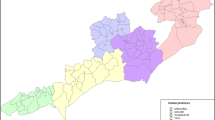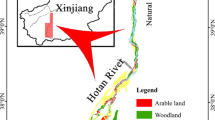Abstract
This research was conducted to determine the water requirements of oasis ecosystem with crop evapotranspiration method, and to analyse the water balance between the supply and requirement using water balance model, and then assess the stability of oasis ecosystem in the middle of Heihe River basin, China. The results indicated that the summations of the water supply and requirement approximated to 82.54 and 110.13 Mm3 years−1 in 2007, and the water deficit was 27.59 Mm3 years−1. The farmland was the largest water consumer with a consumption of 57.07 Mm3 years−1 and accounted for 51.82% of the total water requirements. It was followed by the water area 38.83 Mm3 years−1, forestland 12.13 Mm3 years−1 and domestic and industrial 2.10 Mm3 years−1, and accounted for 35.26, 11.01 and 1.92%, respectively. The stability index was 0.74, which implies that the oasis ecosystem have already started degenerating in sub-stability state. However, the water requirement of unit area was 1243.70 mm years−1 and larger than other oases in arid region of China, which implies that the water resource scarcity do not exist in the middle basin where the excessive waste of the flood irrigation method has broken the balance between the water supply and requirement in the basin scale.





Similar content being viewed by others
References
Abd EI-Ghani MM (1992) Flora and vegetation of Gara oasis, Egypt. Phytocoenologia 21(1–2):1–14
Abdelhadi AW, Takeshi H, Haruya T, Akio T, Tariq MA (2000) Estimation of crop water requirements in arid region using Penman–Monteith equation with derived crop coefficients: a case study on Acala cotton in Sudan Gezira irrigated scheme. Agric Water Manage 45:203–214
Allen RG, Smith M, Pereira LS, Perrier A (1994) An update for the definition of reference evapotranspiration. ICID Bull 43(2):1–31
Allen RG, Pereira LA, Raes D, Smith M (1998) Crop evapotranspiration: guidelines for computing crop water requirements. FAO Irrigation and Drainage Paper 56 FAO, Rome, p 293
Beyazgül M, Kayam Y, Engelsman F (2000) Estimation methods for crop water requirements in the Gediz Basin of western Turkey. J Hydrol 229:19–26
Bormann H, Diekkruger B, Renschler C (1999) Regionalisation concept for hydrological modelling on different scales using a physically based model: results and evaluation. Phys Chem Earth 24(7):799–804
Burman R, Pochop LO (1994) Evaporation, evapotranspiration and climatic data. Elsevier Science, Amsterdam, p 600
Chang XX, Zhao WZ, Zhang ZH, Su YZ (2006) Sap flow and tree conductance of shelter-belt in arid region of China. Agric For Meteorol 138:132–141
Chen DJ, Xu ZM, Chen RS (2003) Design of resources accounts: a case of integrated environmental and economic accounting. Adv Water Sci 14(5):631–637
Chen Y, Zhang DQ, Sun YB, Liu XA, Wang NZ, Savenije Hubert HG (2005) Water demand management: a case study of the Heihe River Basin in China. Phys Chem Earth 30:408–419
Droogers P, Allen RG (2002) Estimating reference evapotranspiration under inaccurate data conditions. Irrig Drain Syst 16(1):33–45
Dyer AJ (1961) Measurements of evaporation and heat transfer in the lower atmosphere by an automatic eddy-correlation technique. Q J Roy Meteorol Soc 87:401–412
Fan ZL (1996) Study on the effect of land development in Xinjiang on ecological environment and corresponding countermeasure. China Meteorological Press, Beijing, p 199 (in Chinese)
Gleick PH (1987) Regional hydrologic consequences of increases in atmospheric carbon dioxide and other trace gases. Clim Change 10(2):137–161
Goldstein AH, Hultman NE, Fracheboud JM, Bauer MR, Panek JA, Xu M, Qi Y, Guenther AB, Baugh W (2000) Effects of climate variability on the carbon dioxide, water, and sensible heat fluxes above a ponderosa pine plantation in the Sierra Nevada (CA). Agric For Meteorol 101:113–129
Goyal RK (2004) Sensitivity of evapotranspiration to global warming: a case study of arid zone of Rajasthan (India). Agric Water Manage 69:1–11
Han DL (1999) The progress of research on oasis in china. Sci Geog Sin 19(4):313–319 (in Chinese with English summary)
Hu SJ, Song YD, Tian CY, Li YT, Li XC, Chen XB (2007) Suitable scale of Weigan River plain oasis. Sci China Ser D 50:56–64
Jensen ME, Burman RD, Allen RG (1990) Evapotranspiration and irrigation water requirements. ASCE Manuals and Reports on Engineering Practice No. 70, p 332
Ji XB, Kang ES, Chen RS, Zhao WZ, Zhang ZH, Jin BW (2005) Estimation of groundwater budget at the representative irrigated area in the middle stream of Heihe River. Hydrogeol Eng Geol 6:25–29 (in Chinese with English summary)
Ji XB, Kang ES, Chen RS, Zhao WZ, Xiao SC, Jin BW (2006) Analysis of water resources supply and demand and security of water resources development in irrigation region of the middle reaches of the Heihe River Basin, Northwest China. Agric Sci China 5(2):130–140
Jia BQ, Zhang ZQ, Ci LJ, Ren YP, Pan BR, Zhang Z (2004) Oasis land-use dynamics and its influence on the oasis environment in Xinjiang, China. J Arid Environ 56:11–26
Kang SZ, Cai HJ, Zhang JH (2000) Estimation of maize evapotranspiration under water deficits in a semiarid region. Agric Water Manage 43:1–14
Kang S, Gu B, Du T, Zhang J (2003) Crop coefficient and ratio of transpiration to evapotranspiration of winter wheat and maize in a semi-humid region. Agric Water Manage 59:239–254
Kashyap PS, Panda RK (2001) Evaluation of evapotranspiration estimation methods and development of crop-coefficients for potato crop in a sub-humid region. Agric Water Manage 50:9–25
Lei J, Luo GP, Zhang XL, Lu Q (2006a) Oasis system and its reasonable development in Sangong River Watershed in North of the Tianshan Mountains, Xinjiang, China. Chin Geogr Sci 16(3):236–242
Lei ZD, Hu HP, Yang SX, Tian FQ (2006b) Analysis on water requirement in oases of the Tarim Basin. J Hydraulic Eng 37(12):1470–1475 (in Chinese with English summary)
Liu CM, Zhang XY, Zhang YQ (2002) Determination of daily evaporation and evapotranspiration of winter wheat and maize by large-scale weighing lysimeter and micro-lysimeter. Agric For Meteorol 111:109–120
Lu L, Li X, Cheng GD (2003) Landscape evolution in the middle Heihe River Basin of north-west China during the last decade. J Arid Environ 53:395–408
Luo GP, Zhou CH, Chen X (2006) Stability of patches of oasis landscape in arid areas: a case study of Sangong River Watershed, Xinjiang, China. Chin Sci Bull 51:92–100
Ministry of Geology and Mineral Resources (1986) Report on groundwater resources assessment. Beijing, China (in Chinese)
Moges SA, Katambara Z, Bashar K (2003) Decision support system for estimation of potential evapotranspiration in Pangani basin. Phys Chem Earth 28:927–934
Nash LL, Gleick PH (1993) The Colorado River basin and climatic change: the sensitivity of stream flow and water supply to variations in temperature and precipitation. US Environmental Protection Agency, EPA230-R-93-009, Washington DC, p 121
Pan XL, Chao JP (2003) Theory of stability, and regulation and control of ecological system in oasis. Global Planet Change 37:287–295
Payero JO, Tarkalson DD, Irmak S, Davison D, Petersen LL (2008) Effect of irrigation amounts applied with subsurface drip irrigation on corn evapotranspiration, yield, water use efficiency, and dry matter production in a semiarid climate. Agric Water Manage 88:1–14
Rivas R, Caselles V (2004) A simplified equation to estimate spatial reference evaporation from remote sensing-based surface temperature and local meteorological data. Remote Sens Environ 93:68–76
Smith M (2000) The application of climatic data for planning and management of sustainable rainfed and irrigated crop production. Agric For Meteorol 103:99–108
Su YZ, Zhao WZ, Su PX, Zhang ZH, Wang T, Ramc R (2007) Ecological effects of desertification control and desertified land reclamation in an oasis–desert ecotone in an arid region: a case study in Hexi Corridor, northwest China. Ecol Eng 29:117–124
Sun HY, Liu CM, Zhang XY, Shen YJ, Zhang YQ (2006) Effects of irrigation on water balance, yield and WUE of winter wheat in the North China Plain. Agric Water Manage 85:211–218
Tang QH, Hu HP, Oki TK (2007) Water balance within intensively cultivated alluvial plain in an arid environment. Agric Water Manage 21:1703–1715
Tanji KK, Kielen NC (2002) Agricultural drainage water management in arid and semi-arid areas. FAO, Rome
Tanner BD, Greene JP (1989) Measurements of sensible heat flux and water vapor fluxes using eddy correlation methods. Final report to US Army Dugway Proving Grounds 9:87–88
Utset A, Farré I, Martínez-Cob A (2004) Comparing Penman–Monteith and Priestley–Taylor approaches as reference-evapotranspiration inputs for modeling maize water-use under Mediterranean conditions. Agric Water Manage 66:205–219
Wang ZJ, Wang HF, Lei ZL (2002) Stability analysis of oasis in arid region. J Hydraulic Eng 5:26–30 (in Chinese with English summary)
Zhang H, Wu JW, Zheng QH, Yu YJ (2003) A preliminary study of oasis evolution in the Tarim Basin, Xinjiang, China. J Arid Environ 55:545–553
Acknowledgments:
This study were supported by the Innovation Research Project of the Chinese Academy of Sciences (No. KZCX2-XB2-04-01) and the National Natural Science Foundation of China (No. 30771767, 40771079). We wish to thank all participants in the surveys conducted in Linze Inland River Basin Research Station, Chinese Academy of Sciences. We gratefully acknowledge the anonymous reviewers for their valuable comments on the manuscript.
Author information
Authors and Affiliations
Corresponding author
Rights and permissions
About this article
Cite this article
Liu, B., Zhao, W., Chang, X. et al. Water requirements and stability of oasis ecosystem in arid region, China. Environ Earth Sci 59, 1235–1244 (2010). https://doi.org/10.1007/s12665-009-0112-7
Received:
Accepted:
Published:
Issue Date:
DOI: https://doi.org/10.1007/s12665-009-0112-7




